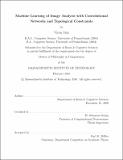Machine learning of image analysis with convolutional networks and topological constraints
Author(s)
Jain, Viren
DownloadFull printable version (8.190Mb)
Other Contributors
Massachusetts Institute of Technology. Dept. of Brain and Cognitive Sciences.
Advisor
H. Sebastian Seung.
Terms of use
Metadata
Show full item recordAbstract
We present an approach to solving computer vision problems in which the goal is to produce a high-dimensional, pixel-based interpretation of some aspect of the underlying structure of an image. Such tasks have traditionally been categorized as ''low-level vision'' problems, and examples include image denoising, boundary detection, and motion estimation. Our approach is characterized by two main elements, both of which represent a departure from previous work. The first is a focus on convolutional networks, a machine learning strategy that operates directly on an input image with no use of hand-designed features and employs many thousands of free parameters that are learned from data. Previous work in low-level vision has been largely focused on completely hand-designed algorithms or learning methods with a hand-designed feature space. We demonstrate that a learning approach with high model complexity, but zero prior knowledge about any specific image domain, can outperform existing techniques even in the challenging area of natural image processing. We also present results that establish how convolutional networks are closely related to Markov random fields (MRFs), a popular probabilistic approach to image analysis, but can in practice can achieve significantly greater model complexity. The second aspect of our approach is the use of domain specific cost functions and learning algorithms that reflect the structured nature of certain prediction problems in image analysis. (cont.) In particular, we show how concepts from digital topology can be used in the context of boundary detection to both evaluate and optimize the high-order property of topological accuracy. We demonstrate that these techniques can significantly improve the machine learning approach and outperform state of the art boundary detection and segmentation methods. Throughout our work we maintain a special interest and focus on application of our methods to connectomics, an emerging scientific discipline that seeks high-throughput methods for recovering neural connectivity data from brains. This application requires solving low-level image analysis problems on a tera-voxel or peta-voxel scale, and therefore represents an extremely challenging and exciting arena for the development of computer vision methods.
Description
Thesis (Ph. D.)--Massachusetts Institute of Technology, Dept. of Brain and Cognitive Sciences, 2010. This electronic version was submitted by the student author. The certified thesis is available in the Institute Archives and Special Collections. Cataloged from student submitted PDF version of thesis. Includes bibliographical references (p. 130-140).
Date issued
2010Department
Massachusetts Institute of Technology. Department of Brain and Cognitive SciencesPublisher
Massachusetts Institute of Technology
Keywords
Brain and Cognitive Sciences.